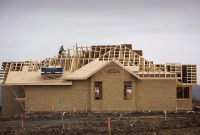An emotional fight over an armoury in rural Nova Scotia could be a precursor of things to come for other small towns as the military moves to get rid of hundreds of buildings across the country.
Confusion has run rampant in Amherst, N.S., a town of 10,000 on the border with New Brunswick, since resident Russell Clarke received a letter from the Department of National Defence a few weeks ago.
"It was quite simple," the 93-year-old Second World War veteran said in an interview. "They said the armoury would go on the block for sale or demolition at some point."
The armoury was built in 1915 and later named after James Layton Ralston, the Amherst native who served as Canada's defence minister for most of the Second World War.
The building was the longtime home of the North Nova Scotia Highlanders, which lost nearly 500 members during the Second World War and remains active as a reserve unit today.
But the Nova Scotia Highlanders, as they are now known, moved to another town in 2006, leaving the unit's regimental museum and three cadet corps as the armoury's only occupants.
Many locals believed at the time that the move was temporary, as the federal government promised to renovate the armoury in 2010.
But fears mounted when the repairs weren't finished, which is why Clarke, who belongs to the North Nova Scotia Highlanders memory club, wrote to National Defence about the building.
Amherst Mayor David Kogon, who sent his own letter to Defence Minister Harjit Sajjan about the armoury in March, said even without the Highlanders, the building remains a focal point for Amherst.
"They need this as a place to train and learn and do their functions," he said of the cadets. "And we have a lot of veterans in this community. There are a lot of people that are being touched by this."
Retired chief warrant officer Ray Coulson, who now runs the Nova Scotia Highlander regimental museum, said without the armoury, the cadet corps and museum would disappear.
"If you're in downtown Ottawa, these things don't seem to be too big a deal," Coulson said. "But when you're out in a town with a population of 10,000, this is a big deal."
When Clarke received National Defence's response, it sent the town into a frenzy, with people expressing outrage and packing the town's council chambers for a meeting on the issue last week.
Sajjan's office insists the government hasn't actually decided whether to get rid of the armoury, and that the letter to Clarke went out in error.
Sajjan's spokeswoman said while the military has indeed declared the building to be surplus, other factors are being considered and the defence minister is still weighing his options.
"While the Amherst Armoury has been assessed by the military to be surplus to operational requirements, no decision has yet been taken on the nature of divestiture," Jordan Owens said in an email.
"This decision involves a thorough analysis and weighing of many factors, including relevant government policies, historical significance, value for public money, and the best interests of the local community."
Yet even if the armoury in Amherst is somehow saved, others in similar communities across the country are likely to be on the chopping block.
The Liberal government, in its recently released defence policy, directed the military to identify and dispose of buildings that were underused or obsolete to save money.
"My gut instinct right now tells me we have way too much infrastructure in the Armed Forces for the size that we are," chief of the defence staff Gen. Jonathan Vance told The Canadian Press in March.
"We have a lot of buildings that we're paying tax on that we don't use."
Defence officials have since started to draw up a list of buildings from the roughly 20,000 the department owns across Canada that they say are no longer needed.
Officials have not released the list or said how many buildings are on it.
But Owens said Sajjan has ordered the department not to get rid of any surplus armouries without his approval.




Comments